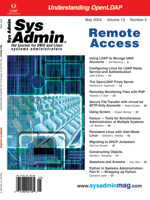 Constructing
Objects Constructing
Objects
Randal L. Schwartz
To construct an object in Perl, you must select a valid package
name for the object's class, populate that package with subroutines
to define the methods, set the value of @ISA within that
package to define the base (parent) classes for that class, and
then create a blessed reference. For example, we can make widgets
that know how to say their names and take on new names with the
following code (I'll describe $self in a moment):
package Widget;
sub display {
my $self = shift;
print $self->{name}, "\n";
}
sub rename {
my $self = shift;
$self->{name} = shift;
$self;
}
A constructed object compatible with this definition must be a hashref
with at least a key of name holding the name of the object.
We can construct such a hashref like so:
my $dog = { name => 'Spot' };
bless $dog, 'Widget';
The bless operation puts a little post-it note on the hash
data structure (not the reference!) that says, "I belong to Widget".
Now, we can invoke the methods like so:
$dog->display; # prints "Spot\n"
$dog->rename("Fido");
$dog->display; # prints "Fido\n"
How does this work? To execute the rename call, for example,
Perl constructs an argument list consisting of the object variable
($dog) plus any arguments given to the method, resulting in:
($dog, "Fido")
Next, Perl looks for a subroutine in the package given by the post-it
note (the object's class) named the same as the method. The subroutine
Widget::rename gets invoked, and the first argument ends up
in $self. The second argument is assigned as an element of
the hash, and finally the subroutine returns $self (not a requirement,
but handy for other operations).
Normally, we wouldn't hand-construct the object. The lines
to create the hash and bless the object will be found in a constructor
within the class. We'll invoke the constructor as:
my $dog = Widget->named("Spot");
To execute this class method invocation, Perl again constructs an
argument list, but this time puts the name of the package as the first
element:
("Widget", "Spot")
And upon finding the Widget::named subroutine, invokes it:
package Widget;
sub named {
my $class = shift; # gets Widget (usually)
my $self = { name => shift };
bless $self, $class;
$self;
}
Comparing this code to the code above, we see that we'll be returning
$self, which is just like the $dog from before. (One
common optimization is to know that bless also returns $self
in this case, so we can leave that last line out with no change in
result.)
For a more detailed explanation of this process, please see my
most recent tutorial book, Learning Perl Objects, References,
and Modules, from O'Reilly & Associates.
Now, why didn't we just hardcode the Widget value
into the bless, and what's up with that "usually"
in the comment? The complication arises when we get to inheritance.
Suppose we have a subclass called ColoredWidget that inherits
from Widget and adds two methods to manage the color of the
widget:
package ColoredWidget;
use base qw(Widget); # sets @ISA
sub color {
my $self = shift;
$self->{color};
}
sub recolor {
my $self = shift;
$self->{color} = shift;
$self;
}
Calling color or recolor on a ColoredWidget uses
the subroutines found in the ColoredWidget package, but calling
named on ColoredWidget uses the @ISA to find
the named routine from the base class, Widget. In this
case, the argument list will look like:
("ColoredWidget", "Spot")
Because the first argument to named is shifted off into $class,
and then used in the bless, we get an object of class ColoredWidget
instead of Widget.
Our display method for ColoredWidget needs a bit
more work, though, if we want the color as well. We can use overriding
to handle that:
package ColoredWidget;
sub display {
my $self = shift;
print $self->name, ", colored ", $self->color, "\n";
}
Now, for ColoredWidget objects, this version of display
is used in preference to the previous version. We can also extend
rather than override by reusing the base class version of display:
package ColoredWidget;
sub display {
my $self = shift;
$self->SUPER::display;
print "[color: ", $self->color, "]\n";
}
Now when we invoke display on a ColoredWidget, we invoke
the first display found in the base class (as if there were
no definition in this class). That invocation produces the name by
itself. Then control returns to this method, and we add the color
in brackets below.
The constructor here is named named because it reads like
what it does: give me a Widget named Spot. But for tradition's
sake, I could also call the constructor new. In fact, I might
make a constructor new that returns an unnamed Widget (the
name left as undef if referenced). This would look like:
package Widget;
sub new {
my $class = shift;
bless {}, $class;
}
Here, a simple reference to an empty hash is generated, blessed into
the right class, and returned. To make Spot, I can now say:
my $dog = Widget->new;
$dog->rename("Spot");
That's a little more clumsy, but it gets the job done.
Another advantage to always naming your constructor as new
is that you can easily create an object that is "like"
another object. For example, if we have an unknown object $object,
we can call ref $object to get its class, then create another
object of the same class by calling new:
my $similar = (ref $object)->new;
But this works only if all of our possible classes of $object
understand the same new method. Fortunately, for the times
we're likely to do this, we've also made the classes work
this way.
Another common operation is cloning: making an object that
is a copy of the current object. It's not enough simply to
copy the reference:
my $puppy = $dog;
This action copies the reference to the data but not the data itself.
So if I rename the $puppy, the $dog changes its name
as well! Cloning is best handled by copying all of the data. A naive
clone could be executed as:
package Widget;
sub clone {
my $self = shift;
my $clone = { %$self }; # copy keys/values one level deep
bless $clone, ref $self; # copy the object class, returning $clone
}
This will work properly for objects that do not have a deep structure,
such as we've seen here so far. But what if one of the object
attributes is a reference to yet another data structure. Again, we're
copying the reference, and not the data, so the data will be shared
amongst the clones. See my column from February 2000 (http://www.samag.com/documents/s=1168/sam0002d/0002d.htm)
for more details on deep copying.
An alternative method of cloning is a more piecemeal approach.
Teach each class in the hierarchy to clone the attributes added
by that class:
package Widget;
sub clone {
my $self = shift;
my $clone = (ref $self)->new; # empty object of same class
$clone->rename($self->name); # copy name attribute
$clone;
}
package SubWidget;
sub clone {
my $self = shift;
my $clone = $self->SUPER::clone; # clone base class stuff
$clone->recolor($self->color); # copy color attribute
$clone;
}
Note the similarity of design. If a class knows that it adds a complex
attribute (a reference to a deeper data structure), then it can add
special copying instructions for that attribute to the new clone.
This is a good OO design, because the information contained within
each base and derived class is maintained closely with the logic on
which it depends.
And now, before I run out of space, I'll touch on a hot-button
for me. The perltoot manpage contains an archetypal new
routine that looks like:
sub new {
my $proto = shift;
my $class = ref($proto) || $proto;
my $self = {};
...
}
The purpose of these few lines of extra code is to permit:
my $other = $dog->new;
to act like:
my $other = (ref $dog)->new;
But here's the problem. When I survey experienced object-oriented
programmers, and ask them what they expect new means when called
on an instance (without looking at the implementation), the result
usually divides rather equally into three camps: those who go "huh,
why would you do that" and think it should throw an error, those
that say that it would clone the object, and those that say
it would copy the object's class but not the contents.
So, no matter what you intend, if you make your new do
one of those three things, two thirds of the people who look at
it will be wrong. It's not intuitive. So, don't write
code like that, and especially don't just cargo-cult that from
the manpage into your code. If you want an object like another
object, use ref explicitly, as shown above. If you want a
clone, put cloning code into your package, and call clone,
as I showed earlier.
I hope you've learned at least one or two things about objects
that you might not have considered before. Until next time, enjoy!
Randal L. Schwartz is a two-decade veteran of the software
industry -- skilled in software design, system administration,
security, technical writing, and training. He has coauthored the
"must-have" standards: Programming Perl, Learning
Perl, Learning Perl for Win32 Systems, and Effective
Perl Programming. He's also a frequent contributor to the
Perl newsgroups, and has moderated comp.lang.perl.announce since
its inception. Since 1985, Randal has owned and operated Stonehenge
Consulting Services, Inc.
|

